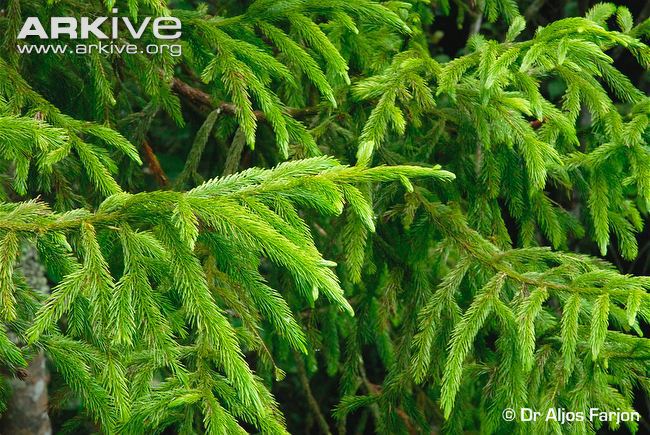Dacrydium gracile was first described by David de Laubenfels in 1988. Was originally listed as D. gracilis. Aljos Farjon says that de Laubenfels spelled it incorrectly that it has to have a feminine ending.
Description. Dacrydium gracile is an evergreen coniferous tree in the podocarpaceae family, growing 20 to 100 feet (7 - 30 m) tall and up to 16 inches (40 cm) in diameter. Juvenile leaves are at least one-half inch (12 mm) long and curved so that the tip is nearly parallel to the branch, are very pungent, triangular in cross section, and lanceolate. Adult leaves are nearly straight, spreading at about a 45 angle but curved so the apex is parallel with the branch, spiny, 0.1 to 0.3 inche (3-9 mm) long, the longer leaves on younger plants or lower on the tree, the shorter leaves on older and exposed trees, and are triangular in cross section. Fertile structures usually occur and lateral branches. Pollen cones are one-quarter inch (6-7 mm) long and 0.08 inch (2 mm) in diameter, subtended by a cluster of leaves 0.15 inch (3-5 mm) long and usually distinctly shorter than normal foliage leaves. The seed-bearing structure also subtended by a cluster of reduced leaves around 0.04 inch (1 mm) long, the bracts of the seed cone up to 0.12 inch (3 mm) long and more or less covering the epimatium, the usually solitary seed itself fully exposed.
The leaves on D. gracile are smaller and much more "gracile" than those of the similar D. magnum which also occurs in lower elevation forest. The crown has a rather typical shape of a forest tree, not the striking form of the usually open growth species, D. beccarii.
Distribution. This species is native to Borneo - Sabah (Mt. Kinabalu and south to the island's center) & Sarawak, at elevations between 3,000 and 5,800 feet (950 - 1,800 m), growing scattered in the canopy of mountain rain forest; in Sarawak also in heath forests on sandstone. It is quite rare in nature.
